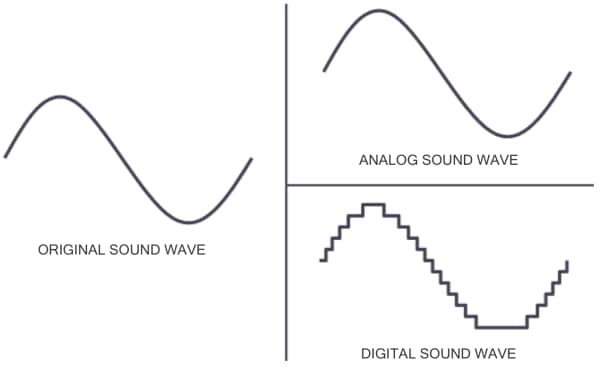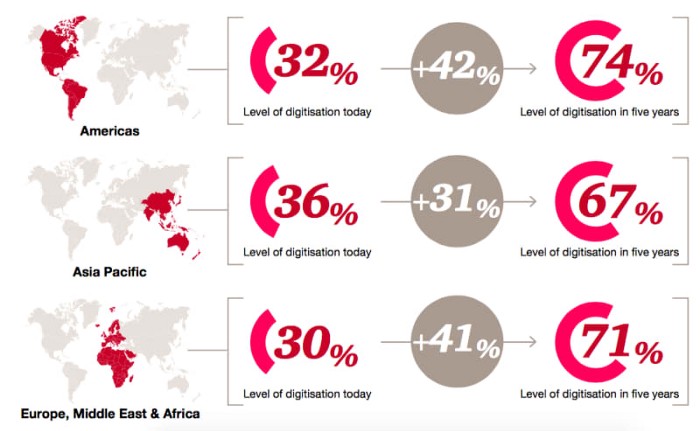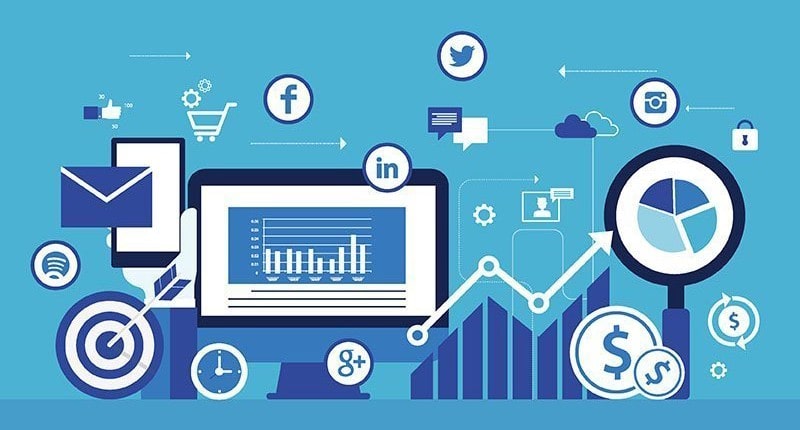What being digital means to us?
Digital Transformation is becoming increasingly inevitable for businesses. But do we fully understand what it means to our business today, why the pressure to go digital is becoming higher now and what new possibilities we can bring to life with digital technologies? Let’s start with the fundamentals.
Understanding the word “digital”
Our human experience of life, experience of the real world, what we see through our eyes, hear through our ears, feel through our touch is all “analog” information in the form of waves, be it sound waves or light waves or heat waves. Human body is a great receptor of “analog” information.
For most people today — “analog” information is just “non-digital” information. We’d say “analog” information is the original, raw source of information of a real-world moment, in an incredibly high resolution.Every single “real-world moment” holds a large amount of information in the form of analog waves (waves of sound, light, temperature, pressure etc).

If we had to capture one real-world moment — say, a couple proposing to each other, on a beach, with birds chirping; earlier an analog camera was used to record the scene onto a photographic film; sounds were recorded on tapes / vinyl discs. Storing large amounts of information, from various moments in life, on physical storage devices like films and tapes wasn’t a scalable idea. Also, with analog storage, there was no means of encrypting the information to keep it secure & guard privacy.
The “digital” disruption
When the “digital” revolution happened (roughly post 1960), it fundamentally changed the way we captured a real-world moment and replayed it later. A real-world moment captured digitally, is a trimmed version of an “analog real-world” moment. Waves are converted into numbers, more precisely into binary information (0 & 1).
Photos on films, are now being stored as JPEG files, Sounds as MP3s. During this conversion, from analog to digital format — some information loss happens, as the original / analog waves are curved; digital information would let go of the curves, take just the straight lines, trying to approximate values. Hence, digitally stored information can never be 100% same as the original (just like how a virtual chat can never match an in person chat), however the resolution we have with digital information today seems to be good enough, to meet business needs.
Also digitally stored information can be easily encrypted and decrypted when needed, bringing in high levels of data security and privacy.
For a business to be digital, it means to gain ability to intensify the experience of real-world moments, for people coming in touch with the brand, by continuously learning from data. This is achieved by creating digital touch-points for users — for example: a mobile app having context rich conversations with users, understanding users, continuously learning from data and intelligently personalizing the customer experience to create higher value.

Source: PWC
Why digital transformation is a need for businesses today?
We’re living in a “digital information age”, where businesses are increasingly wanting to scale faster without physical barriers, better capture real-world moments, replay that information, analyze it, derive insights from it, predict the future, visualize it and take actions.
Today one can carry a pocket-sized disc that carries terabytes of digital information, compressed and stored. Continuous digital data storage for businesses, is really not a challenge — it’s now extremely simple and less expensive.
When we say “your business needs to be digital”
You create digital touchpoints for your customers, employees, businesses / people associated with your business — be it on web, mobile, watches or other smart digital mediums. You regularly record these digital engagements between your brand and people coming in touch with it, replay that information when you need, analyze piles of such information to see patterns, study cohorts & spot opportunities for your brand to better serve people, visualize these opportunities / risks you predict from the data you’ve collected, take data informed decisions & actions to improve the performance of your business in terms of — engagement, transactions and revenues.
You also meaningfully automate some of these tasks, involve machine intelligence to help in this process. Doing this the “analog” way would be near to impossible, as crazy loads of information is collected by businesses everyday.
The Information to Influence cycle

Today, Bots are programmed to do most of these things, be it continuously learning from data (machine learning) or even sometimes proactively engaging with customers, nurturing relationships on behalf of your business (AI automation).
Being digital, might not always intensify your customer experience — specially if you’re in the business of providing say, a “touch based healing” or a sound / radiation therapy. But by adopting digital technologies in your business — you could regularly track health of your customers, learn from data of patients with similar health conditions, analyze data holistically to be able to provide better care.
Intelligent machines + empathetic humans
With the invent of cloud storage, mobile internet and smartphones that can receive or send digital information in realtime — “apps” started becoming a great medium of exchange. Mobile apps, programmed to not just deliver information, but “influence” as well — were soon driving deep, contextual engagements with users, turning out to be an insightful enabler, for people to have meaningful exchanges with your brand.
Smart drones started delivering parcels, seeding crops and carrying out surveillance activity at the borders. Machines were becoming smarter, as they were programmed to study data, derive insights and take actions on their own — pretty much carry out an entire cycle of how a human would study information from the past and take actions in the present. Smart Machines today are replacing humans in jobs that need objective, fast and precise actions. Example: Surgeries were high precision is required, Surveillance at the borders where objectivity is required
Being digital — mature inside out
We’re now in 2017, in a digital-first, AI-first world where businesses are competing against each other, to find that moment of “highest value” on the customer’s journey while engaging with the brand and disrupt it with incredible experiences.
To be able to do this in a highly competitive world, businesses need to be digital-mature, in the way they operate, in the way they deliver their products & services and in the way they deal with their own employees, maturing much faster than their competitors.

Example: If you’re a people-centric organization, committed to developing people, you could use mobile apps to enable your employees’ 360 growth, through continuous peer feedback & ratings; it could also predict learning opportunities and possible career paths (based on data from the external world, on trending career paths). Adopting digital practices internally, will push you to evolve faster as a digital-first business. Codewave’s Peerly — A framework for continuous growth, made easier for adoption using latest digital technologies: https://codewave.com/peerly
We’re today at a point where, businesses have started to adopt “Smart Conversational Bots” to replace humans to create “random moments of deep engagements” with customers. Bots can quickly read information about the user on the other side, listen to the current context of the user (eg: phone number, location, time of the day, timezone, weather etc), analyze historical transactions — and present highly relevant recommendations spontaneously. Bots do it so perfectly that it’s almost hard to imagine, a human agent processing so much data and coming up with a recommendation on the spot, during a conversation with the user. Example: AI powered IVR calls, for making bookings almost replace the need for a human being at a call center, helping a customer to make a booking.
What are some digital transformation trends we see?

- HIGHER SCALE, SPEED FOR YOUR BUSINESS
SCALING UP FAST, ELIMINATING PHYSICAL, GEOGRAPHICAL BARRIERS - DEEPER BRAND ENGAGEMENT
ENHANCED USER EXPERIENCE, DIGITAL TOUCHPOINTS & JOURNEYS - CONTEXT AWARE CONVERSATIONS
CONTEXT RICH HUMAN / BOT INTERACTIONS & PERSONALIZATION - PROACTIVE BUSINESS DECISIONS
DATA VISUALIZATIONS, ACTIONABLE INSIGHTS, PROACTIVE ACTIONS - MEANINGFUL AUTOMATIONS
REALTIME AUTOMATIONS, SIMPLIFICATION OF TASKS & ACCURACY - SIMPLIFIED DATA COLLECTION
BOT LISTENERS, TOUCHPOINTS, IoT SENSORS, CAMERAS, SCANNERS
Digital technologies are aggressively pushing businesses to re-imagine themselves thriving in a highly connected & engaged world; where today’s customers, employees, partners and everyone associated with your business, have already made the shift to “digital” personally in their lives. As machine intelligence evolves, meaningful automations are expected to be integrated with human capabilities, transforming multiple aspects of a business — leaving humans to do more and more influential work.
Codewave is a design thinking led digital transformation company enabling organisations with playful innovation using AI & ML, IoT & Edge, AR, VR, Cloud, Blockchain, and Data.







